当前位置:网站首页>2. Preliminary exercises of C language (2)
2. Preliminary exercises of C language (2)
2022-07-06 13:25:00 【It's Wang Jiujiu】
Catalog
TEXT 1 ( Sum of arithmetic sequence )
TEXT 2 ( Print prime numbers )
TEXT 3 ( Find the greatest common divisor )
TEXT 4 ( Print 1000~2000 Leap year between )
TEXT 5 ( Seeking growth rate )
TEXT 6 ( Print in reverse order )
TEXT 7 ( The scope of the round tower )
TEXT 9 ( Find the perfect number )
TEXT 10( Count the daffodils ( Iteration and recursion ))
TEXT 1 ( Sum of arithmetic sequence )
Calculation 1+2+3+...+100 Combination of
#include<stdio.h>
int main()
{
int i = 0;
int sum = 0;
for (i = 1; i <= 100; i++)
{
sum += i;
}
printf("%d\n", sum);
return 0;
}here sum+=i And sum=sum+i Means exactly the same , Expressed as a variable i Value added to sum On .
TEXT 2 ( Print prime numbers )
Print 100~200 All the prime Numbers between
#include<math.h>
#include<stdio.h>
int main()
{
int i = 0;
int j = 0;
for (i = 100; i <= 200; i++)
{
int num = 0;// Count , Zero at the beginning of each cycle
for (j = 2; j <= sqrt(i); j++)
{
if (i % j == 0)
{
num++;
}
}
if (num == 0)
{
printf("%d\n", i);
}
}
return 0;
}If a number x Non prime number , Then there must be ( One of the factors )<=(x Square root ).
for example :16, form 16 There are three possibilities :1 and 16、2 and 8、4 and 4, here 1、2、4 All less than or equal to 16 Square root , That is to say 4; When 16 Can be 1、2、4 Divisible time , Will also be able to 16、8 and 4 to be divisible by . So when writing code to find factors , Just find its square root to stop .
sqrt For square root , The general format is sqrt(), The header file is <math.h>, The return value is double type , You can use integer variables to receive sqrt The return value of .
TEXT 3 ( Find the greatest common divisor )
Enter two positive integers , Find the greatest common divisor .
#include<stdio.h>
int main()
{
int a = 0, b = 0;
scanf("%d%d", &a, &b);
if (a < b)// Give a large number to a, Decimal to b
{
int i = a;
a = b;
b = i;
}
while (1)
{
int c = 0;
if (a % b != 0)
{
c = b;
b = a % b;
a = b;
}
else
{
printf("%d\n", b);
break;
}
}
return 0;
}The greatest common divisor can be obtained fastest by using the rolling division method , here while(1) Set to dead loop , When finding the greatest common divisor break Out of the loop , Any two positive integers have common divisors 1, Don't worry about dead cycles .
Introduce the rolling division : For example, o 40 and 14 Maximum common divisor of
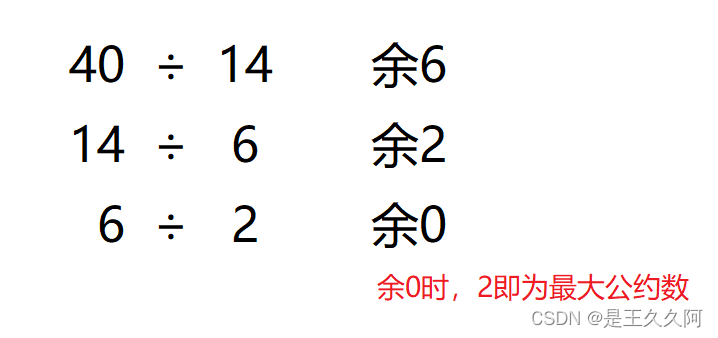
Be careful : The rolling division must be a large number divided by a decimal ! So after entering two numbers , Judge , Assign a large number to a, A small number is assigned to b.
TEXT 4 ( Print 1000~2000 Leap year between )
Print 1000~2000 Leap year between years
#include<stdio.h>
int main()
{
int year = 0;
int count = 0;
for (year = 1000; year <= 2000; year += 4)
{
if ((year % 4 == 0 && year % 100 != 0) || year % 400 == 0)
{
printf("%d ", year);
count++;
}
}
printf("\n1000 Year to 2000 Between years %d Leap years \n", count);//243
return 0;
}
Leap year : A leap in four years , A hundred years without Leap , A leap in four hundred years .
use count Count , Print every leap year +1, At last, it comes to 1000~2000 Between years 243 Leap years .
because year stay for The loop is initialized to 1000,1000 Be able to divide 4, So after each cycle year+=4, This can greatly reduce the number of cycles .
TEXT 5 ( Seeking growth rate )
Suppose the annual growth rate of China's gross national product is r=9%, Calculation n=10 The gross national product of our country will be higher than that of now , What percentage increase . Formula for : .
.
#include<math.h>
#include<stdio.h>
int main()
{
int n = 10;
double r = 0.09;
double p = pow((1+r), n);
printf(" The percentage increase after ten years is %.0lf%%\n", p*100);
return 0;
}Finding the power requires a function pow,pow The general format of the function is pow(a,b), here a Base number ,b Is the index . Use pow The function needs to contain a header file <math.h>. Because it's a percentage , You need to print p*100, And omit the decimal part .
TEXT 6 ( Print in reverse order )
Given integer , Print it in reverse order .
#include<stdio.h>
int main()
{
int num = 12345678;
while (1)
{
if (num / 10 != 0)
{
printf("%d", num % 10);
num=num/10;
}
else
{
printf("%d", num);
break;
}
}
return 0;
}How to get the last number ?( for example 124)
- First cycle :124%10=4, take 4 Print ,124/10=12;
- The second cycle :12%10=2, take 2 Print ,1/10=0;
- Last :0%10=0, Get into else, Print 1,break Out of the loop ;
- What is displayed on the screen is 421 了 .
TEXT 7 ( The scope of the round tower )
4 A radius is 1 Round tower of , The coordinates of the center of the circle are :(2,2)、(-2,2)、(-2,-2)、(2,-2). Except for the round tower , The rest are vacant . Now enter the coordinates x、y, Judge whether the point is in the round tower ( Include boundary ).
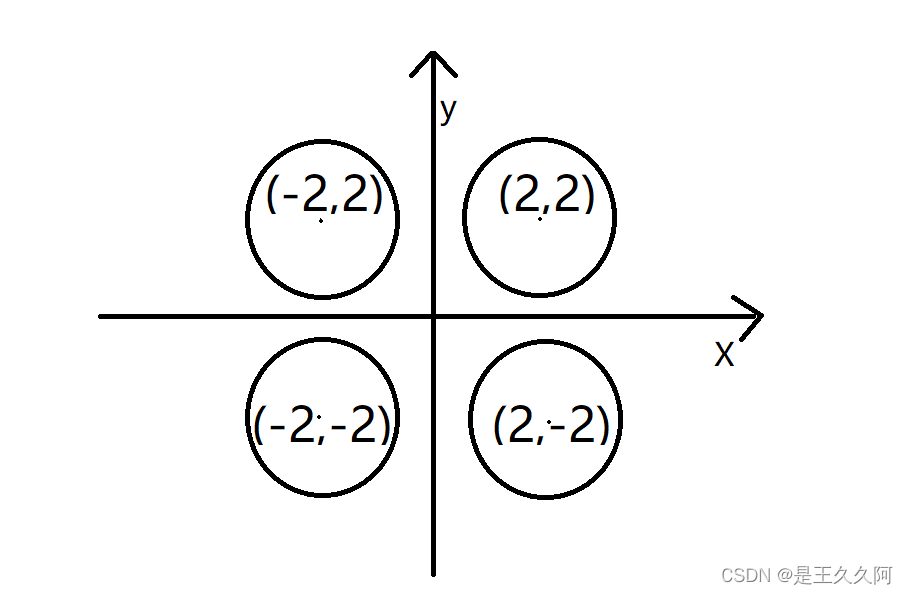
#include<stdio.h>
#include<math.h>
int main()
{
double x = 0.0, y = 0.0;
scanf("%lf%lf", &x, &y);
double d1 = sqrt(pow((x - 2), 2) + pow((y - 2), 2));
double d2 = sqrt(pow((x + 2), 2) + pow((y - 2), 2));
double d3 = sqrt(pow((x + 2), 2) + pow((y + 2), 2));
double d4 = sqrt(pow((x - 2), 2) + pow((y + 2), 2));
if (d1 > 1 && d2 > 1 && d3 > 1 && d4 > 1)
{
printf(" This point is on the open space \n");
}
else
{
printf(" This point is on the round tower \n");
}
return 0;
}Calculation point (x、y) The distance to the center of four circles (sqrt and pow It says , Remember to include header files <math.h>), If all four distances are greater than 1( The radius of the circle ), Then it should be on the open space , Otherwise, it will be on the round tower .
TEXT 8 ( seek 1!+2!+...+n!)
Enter a positive integer n, seek 1!+2!+...+n! Combination of .
#include<stdio.h>
int main()
{
int n = 0;
scanf("%d", &n);
int i = 0;
int j = 0;
int sum = 0;
for (i = 1; i <= n; i++)
{
int ret = 1;// Every reset ret=1
for (j = 1; j <= i; j++)
{
ret *= j;
}
sum += ret;
}
printf("%d\n", sum);
return 0;
}For o 1!+2!+...+n!, First of all, we must be able to ask n! How much is the .
// seek n!
#include<stdio.h>
int n = 0;
int j = 0;
int ret = 1;
scanf("%d",&n);
for (j = 1; j <= n; j++)
{
ret *= j;
}The above part of the code is for n! The factorial , Then put it in for In circulation , Accumulate the results of each factorial .
Note here ,ret For every time n The counting variable in the factorial of , When the factorial is completed , Reset the factorial of the next number to 1, otherwise ret Historical data will be preserved , The result is bigger and bigger .
TEXT 9 ( Find the perfect number )
If a number is equal to the sum of its factors , This number is called the perfect number .
for example :6 The factor is 1、2、3,1+2+3=6, therefore 6 The number is perfect. .( The factor is all the numbers that can divide this number , But not the number itself )
seek 1000 All the completions within , And output in the following format :
6 The number is perfect. , Its factor is :1 2 3
#include<stdio.h>
int main()
{
int i = 0;
int j = 0;
for (i = 1; i < 1000; i++)
{
int sum = 0;
int k = 0;
int arr[50] = { 0 };// Storage factor
for (j = 1; j < i; j++)// Judge the completion part
{
if (i % j == 0)
{
sum += j;
arr[k++] = j;// After ++, First use , Again ++
}
}
if (sum == i)
{
printf("%d The number is perfect. , Its factor is :", i);
for(k=0;arr[k]!='\0';k++)// Traverse the print factor
{
printf("%d ", arr[k]);
}
putchar('\n');
}
}
}
Create a arr To store the factors , Because of the demand 1000 Within the end of , So here arr The space should not be too small , Leave enough space for storing factors . With two for Cycle to judge the completion , Then print out the complete factor traversal .
TEXT 10( Count the daffodils ( Iteration and recursion ))
Count all daffodils , The Narcissus count is a three digit number , The sum of the cubes of each number is equal to itself .
for example : , so 153 It's Narcissus .
, so 153 It's Narcissus .
Iterative method :
#include<stdio.h>
#include<math.h>
int main()
{
int i = 0;
int j = 0;
for (i = 100; i < 1000; i++)
{
int ret = i;
int sum = 0;
for(j = 1; j <= 3; j++)// Find the cubic sum of each digit
{
sum += (int)pow((ret%10), 3);//(int) Cast to type
ret = ret / 10;
}
if (sum == i)// The sum of cubes is equal to itself , Is the number of daffodils
{
printf("%d It's Narcissus \n", i);//153 370 371 407
}
}
return 0;
}Because the number of daffodils is three digits , So in the big cycle ,i The range of is set to 100 <= i < 1000.
Then start every time i The sum of the cubes of the numbers : In order not to change i Value , Create a ret Variable , take i Value is assigned to ret, At the end of each cycle , Will give ret new i value .
The idea here is similar to TEXT 6 The reverse order printing of is somewhat similar , Find the last digit every time , Find the cube sum , use sum recorded , After recording ret/10. The first cycle finds the cubic sum of single digits , The second cycle finds the cube sum of ten digits , The third cycle finds the cubic sum of hundreds , because i It's three digits , So you only need to cycle three times .
sum += (int)pow((ret%10), 3), here (int) Cast to type , take pow Of double The return value of type is converted to integer , Give Way sum receive .( Of course , Even if not converted in VS The compiler can also run successfully )
From the above code, we can observe , In the whole function , We created two local variables to store the results of our process , The whole code is very jumbled , Using recursive methods can simplify our code .
Recursive method :
#include<stdio.h>
#include<math.h>
int flo(int i)
{
int sum = 0;
if (i / 10 != 0)
{
sum = flo(i / 10);
}
return sum += pow((i % 10), 3);
}
int main()
{
int i = 0;
for (i = 100; i < 1000; i++)
{
if (flo(i) == i)
{
printf("%d It's Narcissus \n", i);
}
}
return 0;
}The idea of recursion is a little abstract , Here is a picture to show a better understanding .
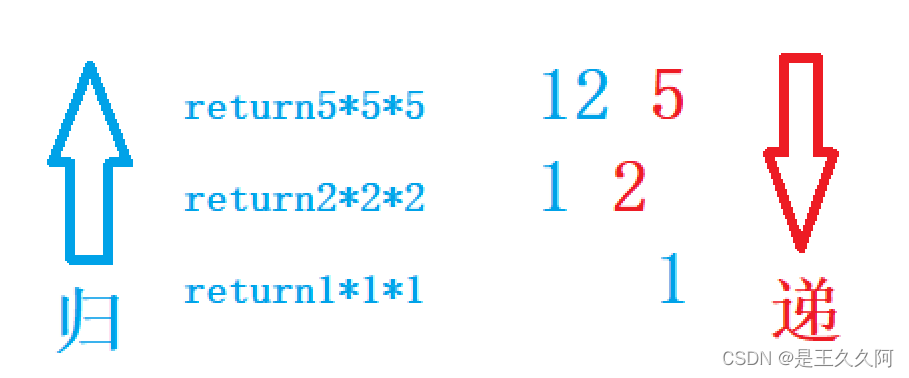
for example : seek 125 Your cube
- First ,125 It can be divided into 12 and 5, seek 5 The cube of + seek 12 Your cube
- secondly ,12 It can be divided into 2 and 5, seek 2 The cube of + seek 1 Your cube
- Last ,1 Just itself , seek 1 The cube of .
The following is the flow chart of recursive call :
return sum += pow((i % 10), 3); It can be understood as :
1、sum += pow((i % 10), 3);
2、return sum;
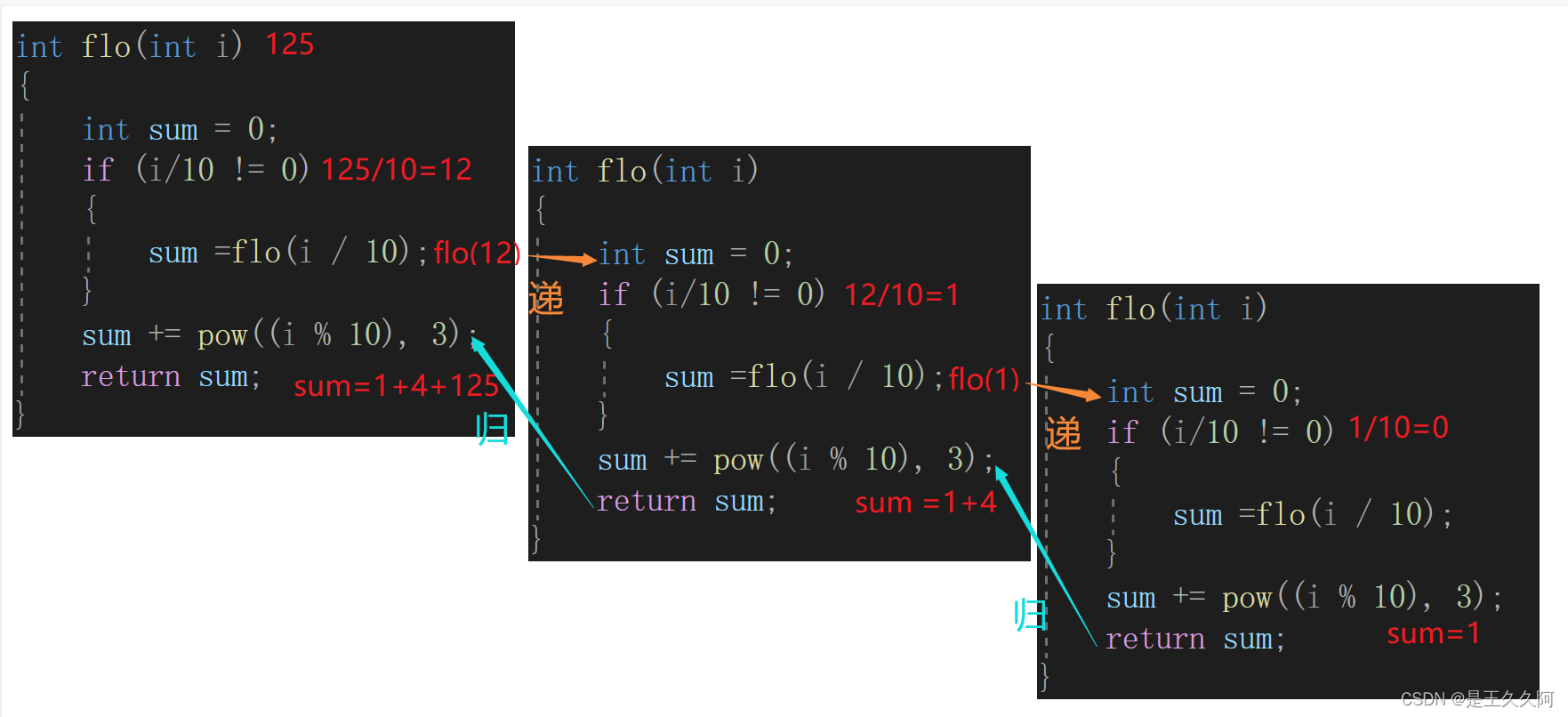
recursive : Is to use functions to call themselves , So as to realize the simplification , Make a big deal small .
Recursion is mainly divided into recursion 、 And return to two parts , Hand it over before returning .
Every time I recurs , Get closer if Bounds in expressions , If there is no boundary , Then infinite recursion , Fall into a dead cycle .
for example 125 Recursive time , When 1/10=0 when , Expression is false , No longer call functions , Start with the next statement , Calculation sum Value , then return To the previous recursion , Until all return End , Recursion ends .
边栏推荐
- MYSQL索引钟B-TREE ,B+TREE ,HASH索引之间的区别和应用场景
- Redis介绍与使用
- IPv6 experiment
- First acquaintance with C language (Part 2)
- MySQL Database Constraints
- Arduino+ds18b20 temperature sensor (buzzer alarm) +lcd1602 display (IIC drive)
- 系统设计学习(二)Design a key-value cache to save the results of the most recent web server queries
- View UI plus releases version 1.1.0, supports SSR, supports nuxt, and adds TS declaration files
- Questions and answers of "Fundamentals of RF circuits" in the first semester of the 22nd academic year of Xi'an University of Electronic Science and technology
- Implement queue with stack
猜你喜欢

10 minutes pour maîtriser complètement la rupture du cache, la pénétration du cache, l'avalanche du cache

String class

6.函数的递归
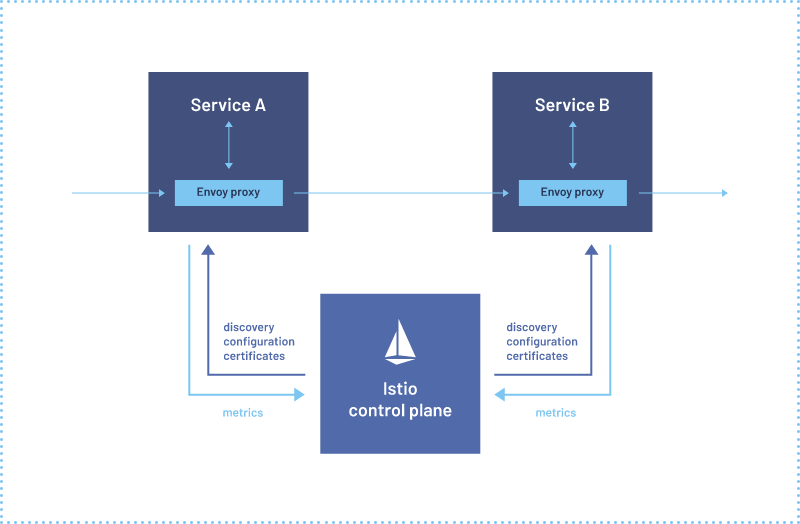
Alibaba cloud microservices (IV) service mesh overview and instance istio

西安电子科技大学22学年上学期《基础实验》试题及答案

20220211-CTF-MISC-006-pure_ Color (use of stegsolve tool) -007 Aesop_ Secret (AES decryption)
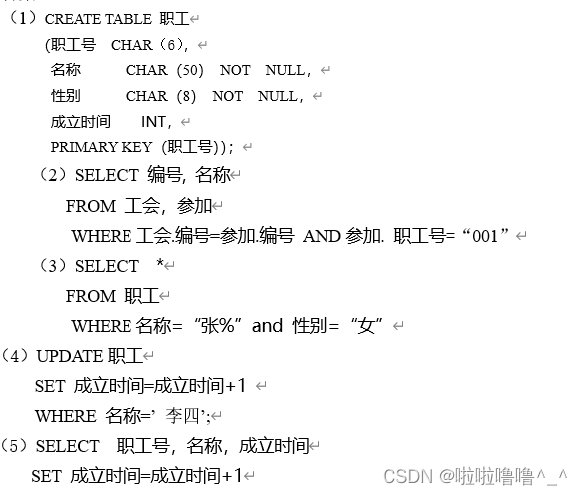
Database operation of tyut Taiyuan University of technology 2022 database

Summary of multiple choice questions in the 2022 database of tyut Taiyuan University of Technology
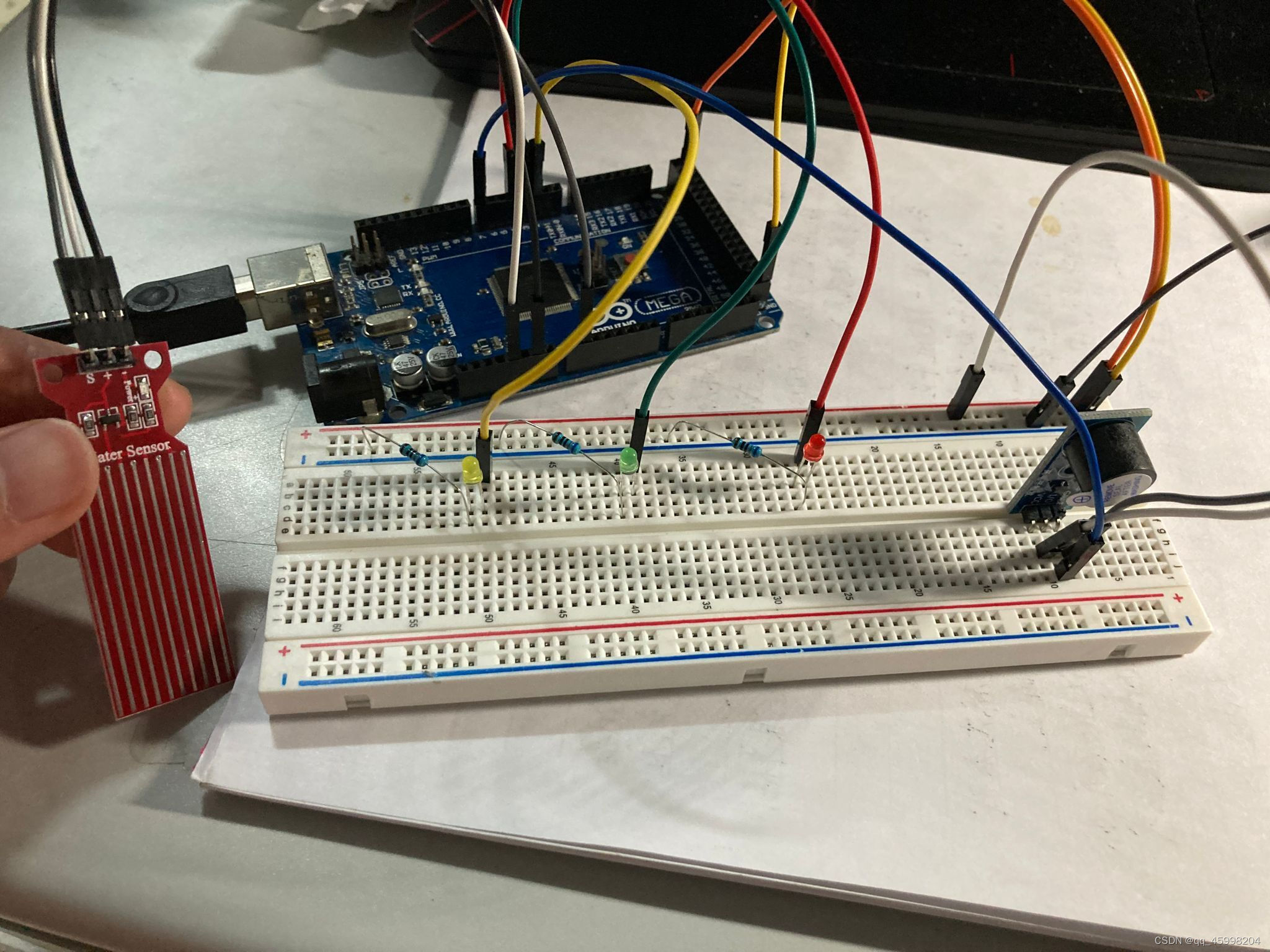
Arduino+ water level sensor +led display + buzzer alarm
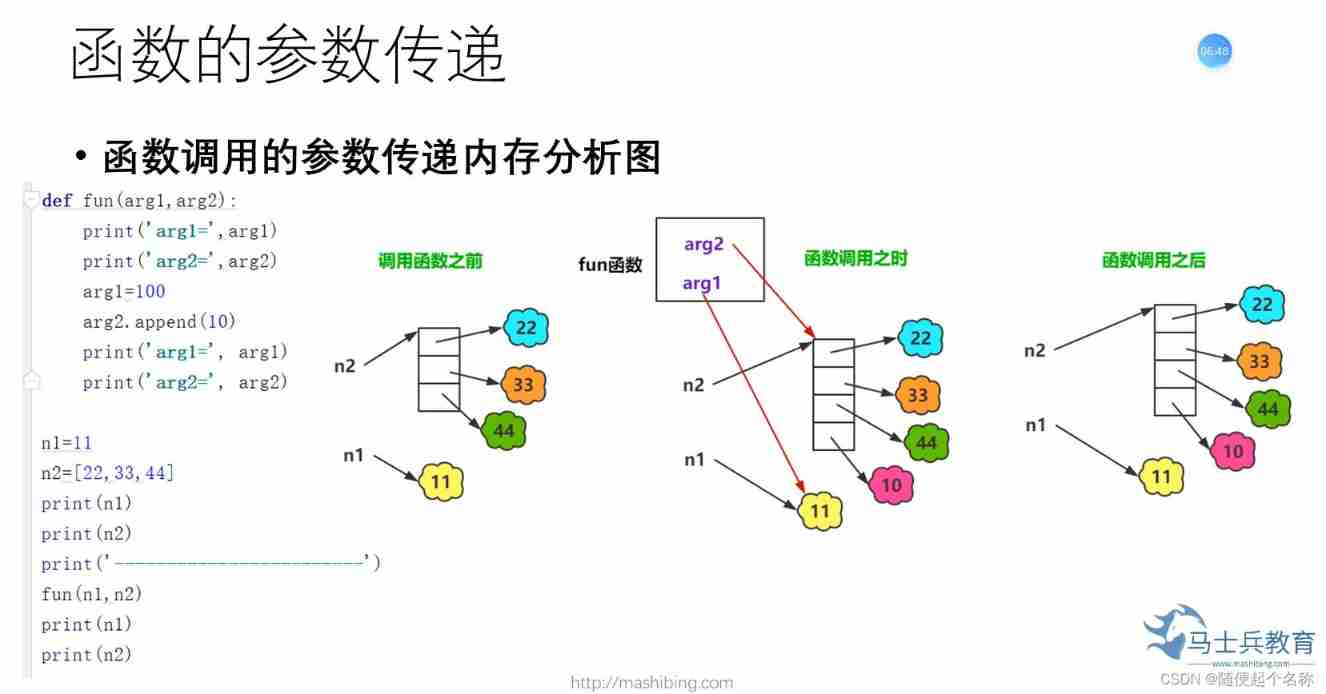
XV Function definition and call
随机推荐
MPLS experiment
Pit avoidance Guide: Thirteen characteristics of garbage NFT project
System design learning (I) design pastebin com (or Bit.ly)
List set map queue deque stack
抽象类和接口
The overseas sales of Xiaomi mobile phones are nearly 140million, which may explain why Xiaomi ov doesn't need Hongmeng
arduino+DS18B20温度传感器(蜂鸣器报警)+LCD1602显示(IIC驱动)
Decomposition relation model of the 2022 database of tyut Taiyuan University of Technology
Solution: warning:tensorflow:gradients do not exist for variables ['deny_1/kernel:0', 'deny_1/bias:0',
十分鐘徹底掌握緩存擊穿、緩存穿透、緩存雪崩
String class
TYUT太原理工大学2022软工导论简答题
继承和多态(下)
What are the advantages of using SQL in Excel VBA
167. Sum of two numbers II - input ordered array - Double pointers
最新坦克大战2022-全程开发笔记-2
View UI Plus 发布 1.3.0 版本,新增 Space、$ImagePreview 组件
Common method signatures and meanings of Iterable, collection and list
面试必备:聊聊分布式锁的多种实现!
1.C语言矩阵加减法